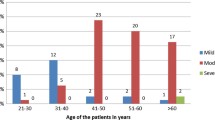Abstract
The aim of this study was to evaluate the prevalence of stress urinary incontinence (SUI) in women in the third trimester of pregnancy. In total, 340 patients attending the Antenatal Clinic at the State University of Campinas (UNICAMP) were interviewed. Overall, 170 women (50%) presented SUI. Stress urinary incontinence did not correlate to either body mass index (BMI) or race. There was no correlation between parity and SUI, but when considering distinct types of effort, urine leakage on coughing (P=0.0478) and laughing (P=0.0046) were highly more frequent in multiparous women. One hundred eleven women had had only vaginal deliveries and 68 delivered by cesarean section. There was no difference between the two groups concerning incontinence, but multiparous women (≥4) who delivered exclusively vaginally demonstrated 2.0 times more chances to leak urine when compared to nulliparous women. This fact strongly suggests parity to be more relevant than delivery route as a risk factor to stress urinary incontinence. Nulliparous women presented with a high percentage (45.5%) of the symptom, emphasizing the elevated risk of SUI during first pregnancy.
Similar content being viewed by others
References
Hunskaar S, Arnold EP, Burgio KL, Diokno AC, Herzog AR, Mallett VT (2000) Epidemiology and natural history of urinary incontinence. Int Urogynecol J 11:301–319
Swift SE (2000) The distribution of pelvic organ support in a population of female subjects seen for routine gynecologic health care. Am J Obstet Gynecol 183:277–285
Marshall K, Thompson KA, Walsh DM, Baxter GD (1998) Incidence of urinary incontinence and constipation during pregnancy and postpartum: survey of current findings at the Rotunda-Lying-in Hospital. Br J Obstet Gynaecol 105:400–402
Hvidman L, Foldspang A, Mommsen S, Bugge Nielsen J (2002) Correlates to urinary incontinence in pregnancy. Int Urogynecol J 13:278–283
Thorp JM Jr, Norton PA, Wall LL, Kuller JA, Eucker B, Wells E (1999) Urinary incontinence in pregnancy and the puerperium: a prospective study. Am J Obstet Gynecol 181:266–273
O’Boyle AL, Woodman PJ, O’Boyle JD et al (2002) Pelvic organ support in nulliparous pregnant and non-pregnant women. Meeting of the 22nd Annual Scientific Meeting of the American Urogynecological Society, 25–27 October 2001, Chicago, IL. Am J Obstet Gynecol 187:99–102
O’Boyle AL, O’Boyle JD, Ricks RE, Patience TH, Calhoun B, Davis G (2003) The natural history of pelvic organ support during pregnancy. Int Urogynecol J 14:46–49
Francis WJA (1960) Disturbances of bladder function in relation to pregnancy. J Obstet Gynaecol Br Emp 67:353–366
Cutner A, Cardozo LD, Benness CJ, Carey A, Cooper D (1990) Detrusor instability in early pregnancy. Neurourol Urodyn 9:328–329
Iosif CS, Ingemarsson I, Ulmsten U (1980) Urodynamic studies in normal pregnancy and in puerperium. Am J Obstet Gynecol 137:696–700
Cardozo L, Cutner A (1997) Lower urinary tract symptoms in pregnancy. Br J Urol 80(Suppl 1):14–23
Nel JT, Diedericks A, Joubert G, Arndt K (2001) A prospective clinical and urodynamic study of bladder function during and after pregnancy. Int Urogynecol J 12:21–26
Abrams P, Cardozo l, Fall M, Griffiths D, Rosier P, Ulmsten U et al (2002) The standardization of terminology of lower urinary tract function: report from standardization sub committee of the International Continence Society. Neurourol Urodyn 21:167–178
Atalah E, Castillo CL, Castro RC, Amparo AP (1997) Propuesta de un nuevo estándar de evaluation nutricional de embarazadas. Rev Med Chile 125:1429–1436
Brasil (2004) Ministério da Saúde. J Febrasgo 11:4–6
Thurman AR, Zoller JS, Swift SE (2004) Non-pregnant patient’s preference for delivery route. Int Urogynecol J 15:308–312
Wijma J, Potters AEW, Wolf BTHM, Tinga DJ, Aarnoudse JG (2001) Anatomical and functional changes in the lower urinary tract during pregnancy. Br J Obstet Gynaecol 108:726–732
Caliha C, Kalia V, Stanton SL, Monga ASH, Sultan AH (1999) Antenatal prediction of postpartum urinary and fecal incontinence. Obstet Gynecol 94:689–694
King JK, Freeman RM (1998) Is antenatal bladder neck mobility a risk factor for postpartum stress incontinence? Br J Obstet Gynecol 105:1300–1307
MacLennan AH, Taylor AW, Wilson DH, Wilson D (2000) The prevalence of pelvic disorders and their relationship to gender, age, parity and mode of delivery. Br J Obstet Gynecol 107:1460–1470
Iosif S (1981) Stress incontinence during pregnancy and puerperium. Int J Obstet Gynaecol 19:13–20
Faundes A, Guarisi T,Pinto-Neto AM (2001) The risk of urinary incontinence of parous women ho delivered only by C-section. Int J Obstet Gynecol 72:41–46
Chirelly P, Campbell F (1997) Incontinence during pregnancy. Prevalence and opportunities for continence promotion. Aust NZJ Obstet Gynaecol 37:66–73
VanDogen L (1981) The anatomy of the genital prolapse. S Afr Med J 60:357–359
Skidmore TE (1999) Redemocratization—New hope, old problems:1985—Race relations. In: Skidmore TE (ed) Brazil—Five centuries of change. Oxford University Press, New York, pp 208–209
Author information
Authors and Affiliations
Corresponding author
Rights and permissions
About this article
Cite this article
Scarpa, K.P., Herrmann, V., Palma, P.C.R. et al. Prevalence and correlates of stress urinary incontinence during pregnancy: a survey at UNICAMP Medical School, São Paulo, Brazil. Int Urogynecol J 17, 219–223 (2006). https://doi.org/10.1007/s00192-005-1361-y
Received:
Accepted:
Published:
Issue Date:
DOI: https://doi.org/10.1007/s00192-005-1361-y



